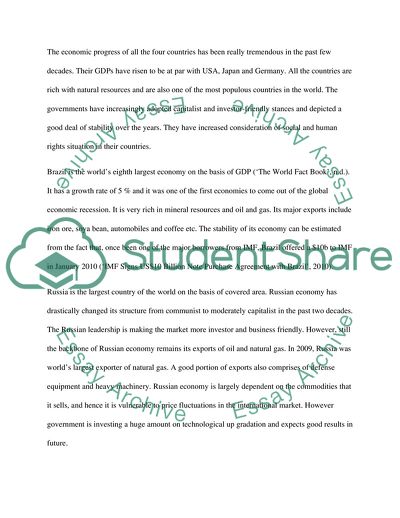Cite this document
(The Rise of the Big Emerging Markets of Brazil, Russia, India, and China Essay Example | Topics and Well Written Essays - 1500 words, n.d.)
The Rise of the Big Emerging Markets of Brazil, Russia, India, and China Essay Example | Topics and Well Written Essays - 1500 words. https://studentshare.org/macro-microeconomics/1746299-820618206does-the-rise-of-the-brics-brasil-russia-india-and-china-portend-to-8206significantly-change-the-international-order-in-the-next-50-years8206
The Rise of the Big Emerging Markets of Brazil, Russia, India, and China Essay Example | Topics and Well Written Essays - 1500 words. https://studentshare.org/macro-microeconomics/1746299-820618206does-the-rise-of-the-brics-brasil-russia-india-and-china-portend-to-8206significantly-change-the-international-order-in-the-next-50-years8206
(The Rise of the Big Emerging Markets of Brazil, Russia, India, and China Essay Example | Topics and Well Written Essays - 1500 Words)
The Rise of the Big Emerging Markets of Brazil, Russia, India, and China Essay Example | Topics and Well Written Essays - 1500 Words. https://studentshare.org/macro-microeconomics/1746299-820618206does-the-rise-of-the-brics-brasil-russia-india-and-china-portend-to-8206significantly-change-the-international-order-in-the-next-50-years8206.
The Rise of the Big Emerging Markets of Brazil, Russia, India, and China Essay Example | Topics and Well Written Essays - 1500 Words. https://studentshare.org/macro-microeconomics/1746299-820618206does-the-rise-of-the-brics-brasil-russia-india-and-china-portend-to-8206significantly-change-the-international-order-in-the-next-50-years8206.
“The Rise of the Big Emerging Markets of Brazil, Russia, India, and China Essay Example | Topics and Well Written Essays - 1500 Words”. https://studentshare.org/macro-microeconomics/1746299-820618206does-the-rise-of-the-brics-brasil-russia-india-and-china-portend-to-8206significantly-change-the-international-order-in-the-next-50-years8206.


